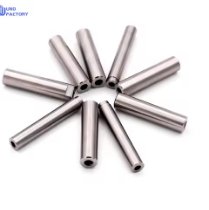Time to read: 6 min

Understanding Stainless Steel
Stainless steel is a versatile metal with a wide range of applications across different sectors. It is known for its resistance to rust and stains, which makes it an ideal material for numerous uses. The creation of stainless steel was a serendipitous discovery that resulted from adding chromium to iron. This addition provides stainless steel with advantages over other metals and alloys.
The Iron, Steel, and Stainless Steel Nexus
To fully appreciate stainless steel, it's important to understand its relationship with iron and steel:
- Iron: A hard and ductile metal, iron is the base material from which steel and stainless steel are derived. It is ferromagnetic and is primarily extracted from hematite ore.
- Steel: An alloy made by combining iron with carbon, steel is stronger and more durable than iron due to the carbon content.
- Stainless Steel: An alloy containing at least 11% chromium, stainless steel is resistant to rust and staining. It may also contain other elements like carbon, nitrogen, silicon, sulfur, niobium, and molybdenum.
Properties of Stainless Steel
- Corrosion Resistance: The chromium content forms a passive oxide layer on the surface, protecting the steel from corrosion.
- Strength: Stainless steel exhibits high tensile strength, allowing it to support significant weight loads.
- Temperature Tolerance: Depending on the type, stainless steel can withstand high temperatures before it melts.
Distinguishing Iron, Steel, and Stainless Steel
The primary differences among these metals lie in their composition and resulting properties. While iron is an element, steel and stainless steel are alloys with unique characteristics. Steel is stronger than iron due to carbon content, and stainless steel offers rust and heat resistance due to chromium.
The Science of Rusting and Stainless Steel's Defense
Rust, or iron oxide, forms when iron and its alloys are exposed to oxygen and moisture. This oxidation process can be accelerated by the presence of water and salt. Rust is not only aesthetically undesirable but also weakens the metal, increases friction, and reduces magnetic and electrical conductivity.
What Makes Stainless Steel Truly 'Stainless'?
The key to stainless steel's resistance to rust lies in its high chromium content, which forms a protective chromium oxide layer on the surface. This passive layer prevents further oxidation and gives stainless steel its characteristic resistance to stains and corrosion.
Stainless Steel in Everyday Applications
Stainless steel's anti-rust and anti-stain properties have made it a popular choice in various applications:
- Kitchenware: Its ease of cleaning and resistance to staining make it ideal for cutlery and cookware.
- Medical Equipment: Stainless steel's ability to resist corrosion and its ease of sterilization make it suitable for medical instruments.
- Food and Catering Industry: It's used for food preparation and service equipment due to its non-reactive nature with food.
- Automotive and Aerospace: Its resistance to rust and lightweight properties make it valuable in vehicle and aircraft manufacturing.
Types of Stainless Steel
Stainless steel is not a single material but a family of materials, each with distinct properties:
- Austenitic Stainless Steel: The most common type, known for its high nickel content, weldability, and corrosion resistance.
- Ferritic Stainless Steel: Characterized by low carbon and high chromium content, offering good corrosion resistance and magnetism.
- Duplex Stainless Steel: A combination of austenitic and ferritic stainless steels, providing high strength and corrosion resistance.
- Martensitic Stainless Steel: With a higher carbon content, it is hard, durable, and suitable for applications requiring wear resistance.
- Precipitation Hardening Stainless Steel: Offers enhanced strength through the addition of elements like copper and niobium.
Conclusion
Stainless steel's unique properties have solidified its place in the modern world. Its resistance to rust and staining, along with its strength and temperature tolerance, make it an ideal material for a variety of applications. Understanding the different types of stainless steel and their specific properties is crucial for selecting the most appropriate material for any given project.
For all your stainless steel manufacturing needs, consider partnering with a reliable and experienced provider like Unofactory. We offer a seamless manufacturing experience, exceptional customer service, and high-quality products at competitive prices.
FAQ
What is in Stainless Steel? Stainless steel is an alloy containing iron, carbon, and at least 11% chromium, along with other elements that contribute to its properties.
What are the 4 Types of Stainless Steel? The four main types of stainless steel are austenitic, ferritic, duplex, and martensitic, each with specific properties and applications.




